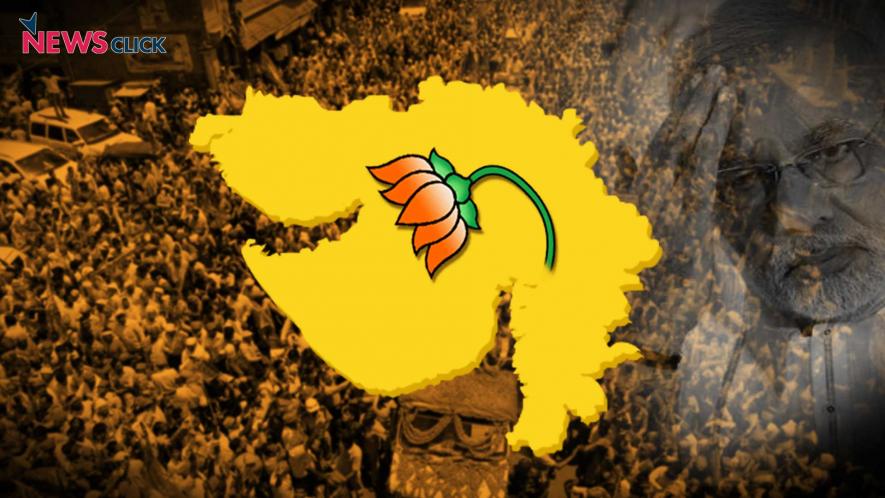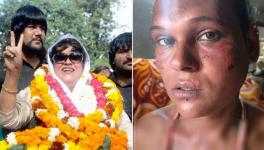Five Riddles of Gujarat Elections

Newsclick Image by Nitesh Kumar
1. How come BJP got 16 seats less than last time yet increased its vote share by 1%?
The strangest thing about this Gujarat election is that BJP suffered a significant loss of seats, dropping from 115 in 2012 to just 99 in 2017, and yet its vote share (percentage of votes it got out of total votes polled) increased by 1%. This riddle is resolved if you look at margins of victory. Average margin of victory for BJP was 29,970 while for Congress it was 13,354. Since BJP was winning more of the urban seats than congress, this means that it got much more votes in urban areas than its rival. In rural areas, Congress had an average margin of just under 13,000 in the 52 seats it won. As many as 11, of the 52 seats were won by margins of under 5,000. In contrast, in the 39 rural seats it won, BJP had an average margin of nearly 18,000. The same pattern held for the urban seats too, with BJP averaging margins of over 26,000 in its 26 wins while the Congress average just about 14,000 in its wins. All this can be put in another way: Congress support was more evenly spread whereas BJP’s support was much more pronounced in urban areas. However, in sum, BJP still leads Congress by almost 6 percentage points margin. Another notable fact is that votes gathered by other parties and independents dipped sharply from 13% to 8% indicating a sharper polarization between the two main rivals.
2. Did BJP lose in rural areas?
The answer is yes if you look at seats but no if you look at how much of the vote they got (vote share). First, let’s look at seats only. In the 98 rural seats, BJP’s tally went down from 50 in 2012 to 40 in 2017. Congress gained 12 seats moving from 43 to 55. In semi-urban (‘rurban’) seats, BJP lost 4 seats while Congress gained 5. In urban areas, BJP retained 33 seats compared to 35 in 2012 while Congress improved from 4 to 6.
Turning to vote shares, the picture is different. BJP improved its vote share in rural areas by one percentage point and in semi-urban areas by five percentage points. In urban areas BJP retained its dominant position with about 59% vote shares in both 2012 and 2017. The Congress pulled abreast of BJP in rural areas but continued to lag behind its rival in semi-urban and urban areas.
3. Did the Patidar agitation help Congress or was it farmers’ anger?
There are an estimated 52 seats with over 20% presence of Patidars. Although BJP won 28 seats this time, down from 36 in 2012, its vote share slightly increased from 49% to 50%. But Congress gained significantly improving its tally from 14 to 23 seats and vote share from 36% to 43%. Clearly, it had gained in this segment which mainly lies in the Saurashtra region of the state. However, this belt is also where farmers’ distress was at its height due to crashing prices of groundnuts and other produce. Their anger turned against BJP and a significant shift to Congress took place. Whether it can be described as a Patidar effect is uncertain. This view is bolstered by the fact that in urban centres of Gujarat, like Surat, many of the Patidar dominated seats did not go to Congress.
4. Who did better among Dalits and Adivasis?
The only measure for finding out the political choices of Dalits and Adivasis is to look at seats reserved for SC and ST candidates respectively. Among the 13 SC reserved seats, Congress improved its tally from 3 in 2012 to 5 this time round, with its vote share increasing only marginally from 40.6% to 41%. The BJP tally dipped from 10 to 7 but its vote share remained almost the same at 48.7% compared to 48.4% in 2012.
Among the 27 seats reserved for STs, Congress retained its dominant position, increasing its tally from 16 in 2012 to 17, with vote share going up from 45.6% to 46.2%. BJP on the other hand declined from 10 to 9 seats but increased its vote share from 40% to 45%.
As can be seen, BJP trails the Congress in terms of vote share among the tribal seats though it is significantly ahead of Congress in dalit seats.
5. What does high NOTA share and low voter turnout indicate?
Both things indicate the same thing: voter disillusionment. NOTA (None Of The Above) is an option on the EVM for those who do not want to vote for any of the contestants. In Gujarat this time, about 1.8% votes (5.5 lakh) were cast for NOTA. There were 29 seats where the winning margin was less than the NOTA votes in the seat. In the context of the election campaign and political atmosphere, where incumbent BJP was under siege, this probably indicates that the NOTA voters were mostly disillusioned with BJP but not impressed by Congress.
In a similar was, the lower rate of polling or turnout can be seen. Turnout dropped from about 72% in 2012 to 68% in 2017. Given the high pitched campaign with PM Modi, 30 Cabinet ministers, and 7 chief ministers from other states campaigning for BJP, not going for voting can only mean a disillusionment and anger at the choices on offer.
Get the latest reports & analysis with people's perspective on Protests, movements & deep analytical videos, discussions of the current affairs in your Telegram app. Subscribe to NewsClick's Telegram channel & get Real-Time updates on stories, as they get published on our website.
























